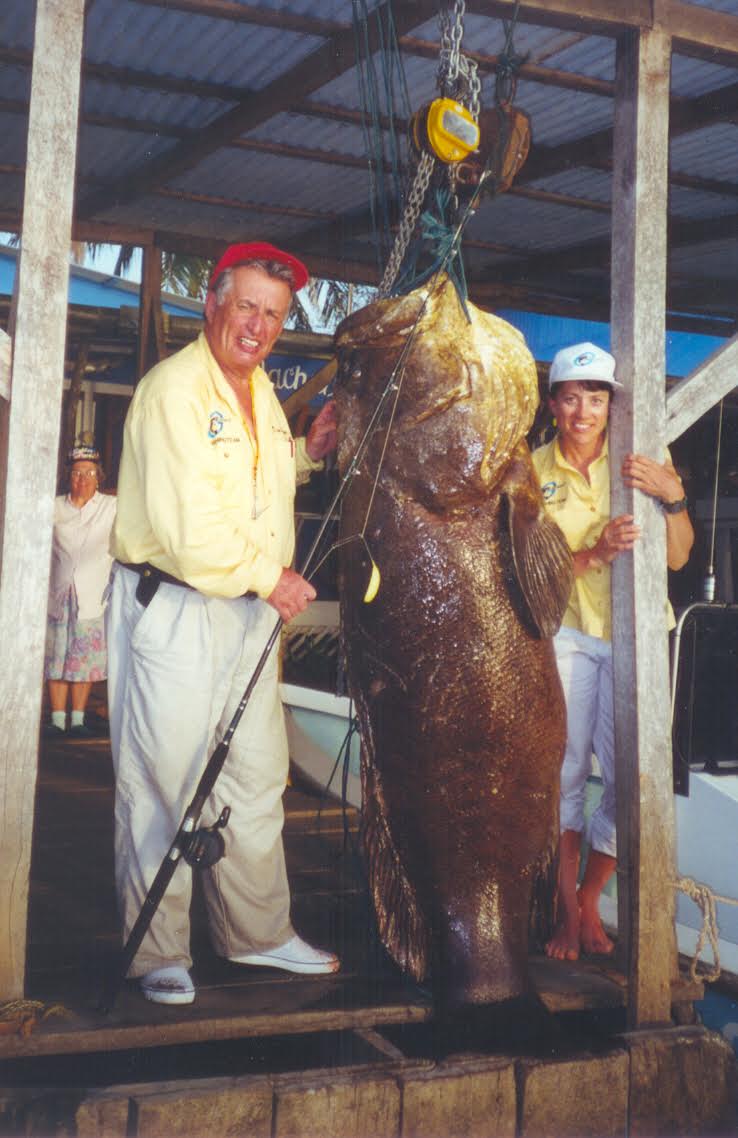Catching a World Record—Intentional or Fluke?
SHARE THIS POST

Hall of Fame fisherman Dan Gapen recounts tales of world record fish caught by and with his longtime fishing partner, “Bobber” Anne.
Accidental snapper
Anne has an official record saltwater fish but quite by accident. It is a 67-pound cubera snapper from the waters of the Rio Colorado River in Costa Rica. I believe it still remains the world record on 30-pound line. Her guide was a local fellow named Henry, working for Dan Wise, owner of Rio Colorado Lodge. Anne caught the big cubera snapper on a 3 1/2-ounce Bait Walker rig loaded with a chunk of yellowtail jack.
Anne also has an unofficial saltwater record––a 243-pound tarpon caught from the same river, but years before. At that time you had to bring in the fish to have it officially recorded, which would have killed the fi sh. Also, since it was 8 feet long and alive, it would have trashed the boat and possibly broken some human bones. Anne had fought the fish almost 2 1/2 hours. Once it was next to the boat, she said she’d like to release it. I was extremely proud of her; it was a shoo-in record but she wanted it to live. She kept one big scale of it before she and Henry allowed it to slip back into the waters of the Rio Colorado. Anne truly displayed top-of-the-line angling ethics.
Back to the snapper story: our party of eight were fishing tarpon, one line with a Flub Dub plug running in the current, another on the bottom with cut bait for bottom fi sh. The record fish took Anne’s bottom rig and fought her for 2 hours and 15 minutes before it was landed. Normally cubera snappers are caught in rocky reefs or sunken wrecks. But here at the mouth of the Rio Colorado the bottom is sand and gravel with no obstructions to cut you off.
The fact that large snappers are found here is unusual—Anne’s record could be considered an accidental fish. One time when Anne and I targeted cuberas, they cut us off 17 times on the wreck they they inhabited. Even when we asked our guide to push the boat away from the wreck upon a strike we would fail. Like large grouper, these wreck-holding snappers sought refuge inside the wreck when hooked, cutting us off each time. We kept trying till we ran out of lead sinkers.
Anne’s huge snapper was boated and kept since we thought it was a record. Back at the resort it was weighed on a certified scale and smashed the old record for 30-pound line by almost 20 pounds. Had she not been over the soft bottom of the Rio Colorado her record would probably not have happened.
Are you enjoying this post?
You can be among the first to get the latest info on where to go, what to use and how to use it!
The giant goliath
I had a similar experience a hundred yards from where Anne took her world record. Twin channels run into the ocean from the Rio Colorado River. Anne caught her record snapper in the southern channel. I hooked a 310-pound goliath grouper in the north channel and fought her for 3 1/2 hours before landing her on a sand bar on the river’s south shore.
As before, we were running one rig for tarpon, another for bottom fi sh. This time my bottom rig consisted of the center section of a yellow tail jack hooked up with a 14/0 hook behind a 10-ounce Bait Walker. That morning Anne and I had helped a native family boat a 380-pound goliath grouper. It took all of us and our guide Gilbert to slide the monster into the family’s 25-foot long canoe. How we did it still baffles me. But I do remember the native dispatching the beast with an axe before getting it into the canoe. Then and there a force rose in me and I wanted to pursue a fish like that.
A point of interest about goliath groupers: most are believed to be born female. Then, when around 49 inches long, some turn male. It is one of six saltwater species with this trait. The largest goliath grouper this writer knows of was 980-pound monster caught by a loading crane on a dock in the port of Limon, Costa Rica. After a night on the town, several sailors disappeared on the way back to their ship when they fell through openings in the dock and into the water. Dock workers fashioned a huge hook and tied a small pig to it, believing an evil monster was under their dock. They hooked this bait to a dock crane, which lowered the pig bait into the water. When the fish struck, she was hooked and the crane pulled her to shore where a truck hauled her out of the water. When cut open, the proof they’d caught their monster was validated as belly contents contained jewelry and skulls from the fish’s victims. As far as I know, the picture still hangs in the sailors’ bar at the end of the commercial 500-foot dock.
If you like fishing, check out the February issue of MidWest Outdoors magazine, available the first full week of February at a newsstand near you, or by subscribing on our website.
MWO
SHARE THIS POST
You may also like...
Nothing found.
Did you enjoy this post?
You can be among the first to get the latest info on where to go, what to use and how to use it!